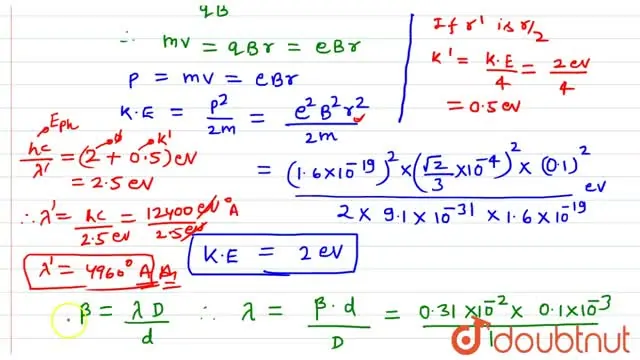The path of photoelectrons emitted due to electromagnetic radiation incident on a sample of material A, is found to have a maximum bending radius of 0.1 m in a magnetic field of (√23)×10−4T. When the radiation is incident normally on a double slit having a slit separation of 0.1mm, it is observed that there are 10 fringes in a width of 3.1 cm on a screen placed at a distance of 1 m from the double slit. Find the work function of the material. and the corresponding threshold wavelength. What sould be the wavelength of the incident light so that the bending radius is one-half of what it was before? Given that mass of the electron=0.5MeVc2,hc=12400eV−A
The bending radias r of a particle of mass m and charge e moving with a velocity v in a uniform magnetic field is given by
mv2r=evB, e being the charge and B the strength of the firld.
Momentum, mv=Ber ..(i)
When the em radiation, λ, satisfies, FW=λDd
λ=dD×FW
=0.1×10−3×3.1×10−31m=3100A
The kinetic energy of the electron is
KE=(Ber)22m=(Brec)22mc2=(√23×10−4×10−1×3×108)22×0.5×106=2eV
The threshold wavelength is given by
hcλ=KE+hcλth
124003100=2+hcλth
hcλth=2eV,λth=124002=6200A
The kinetic energy of the most energetic photoelectron is directly proportional to the square of the radius of its track in a magnetic field. So, if the bending radius is half of what it was before, the kinetic energy of the electron is one-fourth of the previous value.
(KE')=2×(12)2eV or 0.5eV
The wavelength, λ, is given by
hcλ=2eV+0.5eV=2.5eV
⇒λ=124002.5=4960A
Related Playlists
- BOOK - CENGAGE PHYSICS ENGLISHCHAPTER - PHOTOELECTRIC EFFECTEXERCISE - Single Correct130videos
PHOTOELECTRIC EFFECT
- BOOK - CENGAGE PHYSICS ENGLISHCHAPTER - PHOTOELECTRIC EFFECTEXERCISE - Multiple Correct10videos
PHOTOELECTRIC EFFECT
- BOOK - CENGAGE PHYSICS ENGLISHCHAPTER - PHOTOELECTRIC EFFECTEXERCISE - Exercise 3.28videos
PHOTOELECTRIC EFFECT
- BOOK - CENGAGE PHYSICS ENGLISHCHAPTER - NUCLEAR PHYSICSEXERCISE - ddp.5.514videos
NUCLEAR PHYSICS
- BOOK - CENGAGE PHYSICS ENGLISHCHAPTER - RAY OPTICSEXERCISE - DPP 1.612videos
RAY OPTICS
Similar Questions
Light of wavelength 5000A0 is incident on a slit. The first minimum of the diffraction pattern is observed to lie at a distance of 5 mm from the central maximum on a screen placed at a distance of 3 m from the slit. Then the width of the slit is
View SolutionLight of wavelength 589.3nm is incident normally on the slit of width 0.1mm. What will be the angular width of the central diffraction maximum at a distance of 1m from the slit?
View SolutionLight of wavelength 6×10−5 cm falls on screen at a distance of 100 cm from a narrow slit. Find the width of the slit if the first minima lies 1mm on either side of the central maximum
View SolutionWidth of the principal maximum on a screen at a distance of 50 cm from the slit having width 0.02 cm is 312.5×10−3cm. If waves were incident normally on the slit, then wavelength of the light from the source will be
View SolutionThe separation between the. consecutive dark fringes in a Young's double slit experiment is 1 mm. he is placed at a distance of 2.5 m from the slits screen s and separation between the slits is 1.0 mm. Calculate the he wavelength of light used for the experiment.
View SolutionIn young's double slit experiment with monochromic light, fringes are obtained on a screen placed at some distance from the plane of slits. If the screen is moved by 5 cm towards the slits, then the change in fringe width is 30μm if the distance between the slits is 1mm, then calculate wavelength of the light used.
View SolutionLight of wavelength 6000A0 is incident on a single slit. The first minimum of the diffraction pattern is obtained at 4 mm from the centre. The screen is at a distance of 2m from the slit. The slit width will be
View SolutionIn youngs double slit experiment the fringes are formed at a distance of 1m from double slits of sepration 0.12mm .calculate the distance of 4th dark band from the centre of screen ?(wavelength is 12000A).
View SolutionIn Young's double-slit experiment, the slit are 0.5 mm apart and the interference is observed on a screen at a distance of 100 cm from the slits, It is found that the ninth bright fringe is at a distance of 7.5 mm from the second dark fringe from the center of the fringe pattern. The wavelength of the light used in nm is
View SolutionLight of wavelength 6328Å is incident normally on a slit having a width of 0.2mm. The distance of the screen from the slit is 0.9m. The angular width of the central maximum is
View Solution


